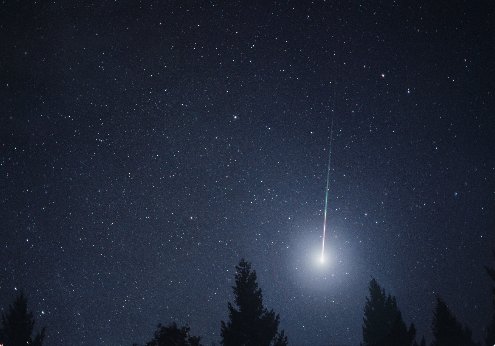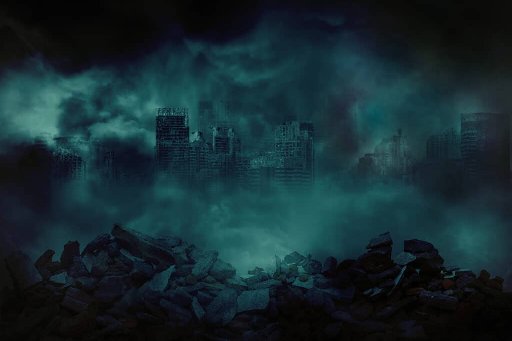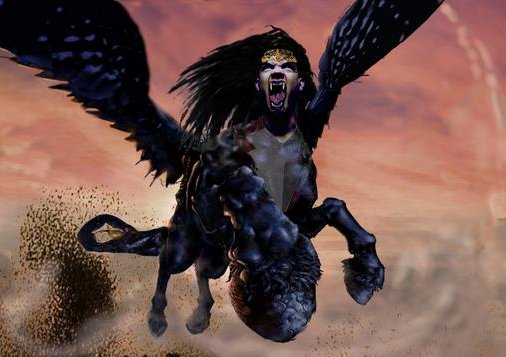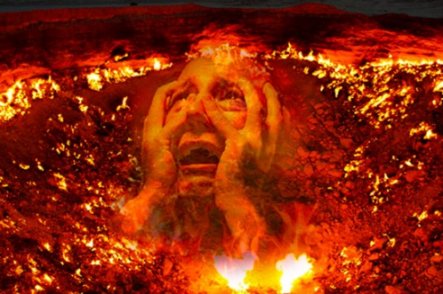Month 8:15, Week 2:7 (Shibi'i/Sukkot), Year:Day 5955:222 AM
2Exodus 9/40
Gregorian Calendar: Wednesday 9 November 2022
Book of Revelation XXXIV
The Seven Shofar Judgments III
The 5th Plague & 1st Woe (Part 2)
Locust Nightmare (Revelation 9:1-12)

Continued from Part 34
Introduction
Shabbat Shalom kol beit Yisra'el and Mishpachah and welcome back to our study of the locust-like creatures from the deep pit. Last week we took a look at the first 6 verses of Revelation 9:1-12; today we're going to conclude this section by looking at the unusually specific description of them which must have been given for a reason because of the very specific task they have been chosen for. But first let's briefly recap what we covered last time.
Recapitualation - the Fallen Star
We began by concluding that the fallen star was Satan himself and that this 'fall' took place a very long time ago. He would have been known by his proper name Heylel back then, thereafter to be known as Lucifer and haSatan; recall that both of these titles are not proper names - Lucifer comes from the Latin, meaning 'bringer of light' and haSatan (literally 'the satan') comes from the Hebrew, meaning 'the adversary' or 'the one who resists'. Many wrongly interpret this passage to mean that Satan and his demonic hosts don't 'fall' from heaven to earth until the very end when in actual fact they have been down here from the very earliest times. We know from Job that the devil was roaming the earth from this the oldest book of the Bible (Job 1:7; 2:2). We also saw that stars, when not referring to literal heavenly bodies, are symbols of ruling angelic powers, both the good and the evil.
 Satan has been down here a very long time
Satan has been down here a very long time
Ordinary Demons Greatly Fear the Creatures of the Deep Pit
We saw that the pit from which the locust-like beings emerge is not 'bottomless' but very deep indeed which gives the reader a sense of just how dark 'darkness' can be because of how far down the bottom is. These are not run-of-the mill demons but greatly feared by the rank-and-file of their own kind because of the power they are able to wield. The nearest parallel I can think of is life in Stalinist Russia where no one knew from one minute to the next whether they would be denounced, tortured and murdered even if they believed and did what they thought their overlords wanted. Human tyranies, like the demonic realm, maintain power and operate using fear and terror.
 The very deep Pit seems to be bottomless
The very deep Pit seems to be bottomless
Even the demonic cluster of demons known as 'Legion', whom Yah'shua (Jesus) cast out of a possessed man, begged not to be sent to the pit! They preferred to inhabit pigs on earth than deal with the inhabitants of that place! Since the pigs were subsequently drowned, either it was to the Pit they were eventually sent or else they resumed their wanderings on the earth in search of another victim.
 Legion preferred the company of pigs to the Pit
Legion preferred the company of pigs to the Pit
An Adventist Doctrine of the Millennium & Other Case Studies
We also looked at the Seventh-Day Adventist belief about the millennium as a case study on how to misinterpret Scripture to remind you to be rigorous when studying the Davar (Word) and above all to look at context. We'll take a couple more case studies today later on if we have the time because it's as well to understand the mistakes people commonly make so that we don't go and make them too. This is particularly important when it comes to prophecies about the future where poorly informed exegetes typicallly stumble. I should add this important point: some prophecies are not meant to be understood until the events they depict are actually happening, and this so that believers may acknowledge the omniscience of Elohim (God) and give Him glory.
 How Adventists think the Millennium will look like
How Adventists think the Millennium will look like
Not a Sin Not Having All the Answers
To therefore admit, saying, 'I don't know what this means' is no shame, especially if it's a Bible teacher saying it, because no teacher knows everything. We all have different areas of expertise, a reason teachers should consult one another. Most teachers speculate and many of those speculations turn out to be wrong. That's OK so long as they make a point of admitting that they don't know the answers to a particulat question and confess their speculations might be wrong. Otherwise we should limit ourselves to teaching what we actually know and not what we think we know. You don't have to be supremely confident in a particular understanding to be a good teacher. Indeed I would like to suggest to you that one of the greatest problems in the world is that intelligent people have doubts and stupid people are supremely confident. And there is no better example of the latter than those arguing for a flat earth who not only have an abysmal knowledge of science but, more dangerously, if they have a poor ability to interpret Scripture and so try to wed two systems of knowledge together - of science and theology. There's a reason scientists require a lot of training to be rigorous and why there is a special office of Teacher for local congregations (Eph.4:11). Unlike nevi'im (prophets), teachers have to do a lot of hard research work. So some healthy self-doubt is not a bad thing because it often witnesses of humility and will prevent a teacher from saying outrageous things. There are more false teachers, as a rule, than true ones because their motive for teaching is wrong (2 Tim.4:3) whether it is to get a reputation and a following or something else.
Literal Monsters & a Picture of the Time the Wicked Spend in Hell
 We also discussed the similaries between the darkness of the 8th and 9th Egyptian plagues and the thick darkness these locust-like beings bring with them from the pit. The demon-god of the 9th plague was Ra (see right) who may be the Egyptian equivalent of Abbadon, the king of the locust-like creatures. If one is literal (which the Egyptians plages were) then the other must be literal too. Because of it, these creatures will be hard to see until they're virtually on top of their victims by which time it will be impossible to flee from them and prevent themselves being afflicted.
We also discussed the similaries between the darkness of the 8th and 9th Egyptian plagues and the thick darkness these locust-like beings bring with them from the pit. The demon-god of the 9th plague was Ra (see right) who may be the Egyptian equivalent of Abbadon, the king of the locust-like creatures. If one is literal (which the Egyptians plages were) then the other must be literal too. Because of it, these creatures will be hard to see until they're virtually on top of their victims by which time it will be impossible to flee from them and prevent themselves being afflicted.
Not Modern Military Equipment
We understood that these monsters from the depths weren't a representation of modern-day military equipment like attack helicopters but are actual supernatural beings with personality and will. Finally, we took at look at the symbolic numbers involved in the text in a bid to understand why this torment of the wicked lasted precisely five months, and understood that this period of punishment was, whilst a future literal event, also symbolic of the time the wicked dead spend in hell, being of fixed duration and not 'eternal' as most denominations teach. Nor will annihilationists find any support for their peculiar belief here either
 John didn't see see modern military equipment
John didn't see see modern military equipment
REVELATION 9:7-12
With that said, let's re-read the second part of last week's passage and get stuck in again:
"7 The shape of the locusts (Joel 2:4-6,25; Amos 7:1-3; Nahum 3:15-17) was like horses prepared for battle. On their heads were crowns (Nahum 3:15-17) of something like gold, and their faces were like the faces of men (Dan.7:8). 8 They had hair like women's hair, and their teeth were like lions' teeth (Joel 1:4-6). 9 And they had breastplates like breastplates of iron, and the sound of their wings was like the sound of chariots with many horses running into battle (Joel 2:5). 10 They had tails like scorpions, and there were stings in their tails. Their power was to hurt men five months. 11 And they had a king over them the malak (angel) of the very deep (bottomless) pit (abyss) (Lk.8:31), whose name in Hebrew (Rev.16:16) is 'Avadu (Abaddon) (Job 26:6; 28:22; 31:12; Ps.88:11), but in Greek he has the name Apollyon, and in Aramaic his name is Sh'ra (='loosed'). 12 One woe is past. Behold, still two more woes are coming after these things" (Rev.9:7-12, NKJV + HRV)
An Insight into the Nature of Hell
When Yahweh gives as much detail as this, as He does here in verses 7-11, it means we're supposed to pay close attention because we need this information. He isn't giving it to simply make us quake in our boots like the producer of a horror movie. We are given this long description of what these 'locusts' look like, so this knowledge must be important for all readers in all generations. I think we saw why last week for like I said, we're getting an insight into what happens to the wicked after they are sent to the hell or Prison section of Sheol. Why would He want us to read about that? Well, for all the obvious reasons - so that we don't deceive ourselves into believing that sin has no inconsequences and so we don't fall for the lie that the key to this prison cell will be thrown away forever.
A Right Attitude Toward Sin Makes Us Better Witnesses
With a right attitude toward sin we will all the more urgently warn people that you don't just 'cease to exist' when you die. We can warn them of the false belief that there are no consequences for the way we conduct the life we live down here (as atheists and annihilationists believe, though annihilationists tend to rather cruelly believe that Yahweh first tortures the wicked and then exterminates them, which seems to me to be almost as wicked as the Calvinist belief in eternal torture for those who were supposedly predestined to hell without them having the freedom to choose anything.
The Imagery Should Be Familiar to the Bible Student
So why we are given this detailed anatomy of the pit monsters? First let's remember that these aren't actual 'locusts' which on this world harm vegatation, not human beings, though famine is often the lot of the rapacious gluttony of locust swarms on mankind's crops. The words 'like' and 'as' are used 9 times, as if unlearnèd people need to be persuaded at this juncture that what we're looking at aren't earthly, natural creatures but supernatural ones. We're told what their front part looks like in verses 7-8, their middle part in verse 9, and their end part in verse. And this is not the first time such creatures have been described in Scripture! (That's, incidentally, the context of the 'blow the trumpet in Zion' passage that we sing in one of our songs too). So this imagery would have been familiar to John's early readers and ought to be to us too if we have been diligent students of the Bible! Nothing we're reading here is actually out-of-the-ordinary or extraordinary for the Bible student. So let's now carefully dissect the symbolism:
"In appearance, the locusts looked like horses prepared for battle. They had what seemed to be crowns of gold on their heads, and their faces were human faces. They had hair like women's hair, and their teeth were like lions' teeth. They had breastplates like iron breastplates, and the sound of their wings was like the noise of many horse-drawn chariots charging into battle. They have tails like scorpions' tails, and stings as well, and their tails have the power to harm people for five months" (Rev.9:7-10, KNT, adapted).
 The pit monsters are demonic supernatural beings
The pit monsters are demonic supernatural beings
The Joel 2 Prophecy
As I just hinted, much of the interpretation is to be found in the 'Blow the trumpet in Zion' passage of Joel 2 so let's read that now and hopefully some things will start clicking in your minds. This is all part of the same narrative:
"1 Blow the trumpet (shofar) in Zion, and sound an alarm in My qadosh (holy, set-apart) mountain! Let all the inhabitants of the land tremble; for the day of Yahweh is coming, for it is at hand: 2 A day of darkness and gloominess, a day of clouds and thick darkness, like the morning clouds spread over the mountains. A people come, great and strong, the like of whom has never been; nor will there ever be any such after them, even for many successive generations.
"3 A fire devours before them, and behind them a flame burns; the land is like the Garden of Eden before them, and behind them a desolate wilderness; surely nothing shall escape them. 4 Their appearance is like the appearance of horses; and like swift steeds, so they run. 5 With a noise like chariots, over mountain tops they leap, like the noise of a flaming fire that devours the stubble, like a strong people set in battle array.
"6 Before them the people writhe in pain; all faces are drained of colour. 7 They run like mighty men, they climb the wall like men of war; every one marches in formation, and they do not break ranks. 8 They do not push one another; every one marches in his own column. Though they lunge between the weapons, they are not cut down. 9 They run to and fro in the city, they run on the wall; they climb into the houses, they enter at the windows like a thief.
10 The earth quakes before them, the heavens tremble; the sun and moon grow dark, and the stars diminish their brightness. 11 Yahweh gives voice before His army, for His camp is very great; for strong is the One who executes His davar (word). For the day of Yahweh is great and very terrible; who can endure it?
"12 'Now, therefore,' says Yahweh, 'Turn to Me with all your heart, with fasting, with weeping, and with mourning.' 13 So rend your heart, and not your garments; return to Yahweh your Elohim (God), for He is gracious and merciful, slow to anger, and of great kindness; and He relents from doing harm. 14 Who knows if He will turn and relent, and leave a blessing behind Him -- a grain offering and a drink offering for Yahweh your Elohim (God)?
15 Blow the trumpet (shofar) in Zion, consecrate a fast, call a sacred assembly; 16 Gather the people, sanctify the congregation, assemble the elders, gather the children and nursing babes; Let the bridegroom go out from his chamber, And the bride from her dressing room. 17 Let the cohenim (priests), who minister to Yahweh, weep between the porch and the altar; let them say, 'Spare Your people, O Yahweh, and do not give Your heritage to reproach, that the nations should rule over them. Why should they say among the peoples,'Where is their Elohim (God)?''
18 Then Yahweh will be zealous for His land, and pity His people. 19 Yahweh will answer and say to His people, 'Behold, I will send you grain and new wine and oil, and you will be satisfied by them; I will no longer make you a reproach among the nations.
"20 'But I will remove far from you the northern army, and will drive him away into a barren and desolate land, with his face toward the eastern sea and his back toward the western sea; his stench will come up, and his foul odour will rise, because he has done monstrous things.'
"21 Fear not, O land; be glad and rejoice, for Yahweh has done marvelous things! 22 Do not be afraid, you beasts of the field; for the open pastures are springing up, and the tree bears its fruit; the fig tree and the vine yield their strength. 23 Be glad then, you children of Zion, and rejoice Yahweh your Elohim (God); for He has given you the former (latter) rain faithfully, and He will cause the rain to come down for you -- the former rain, and the latter rain in the first month (Aviv). 24 The threshing floors shall be full of wheat, and the vats shall overflow with new wine and oil.
"25 'So I will restore to you the years that the swarming locust has eaten, the crawling locust, the consuming locust, and the chewing locust, My great army which I sent among you. 26 You shall eat in plenty and be satisfied, and praise the name of Yahweh your Elohim (God), who has dealt wondrously with you; and My people shall never be put to shame. 27 Then you shall know that I am in the midst of Israel: I am Yahweh your Elohim (God) and there is no other. My people shall never be put to shame.
"28 'And it shall come to pass afterward that I will pour out My Ruach (Spirit) on all flesh; your sons and your daughters shall prophesy, your old men shall dream dreams, your young men shall see visions. 29 And also on My menservants and on My maidservants I will pour out My Ruach (Spirit) in those days (Acts 2:17-18).
"30 'And I will show wonders in the heavens and in the earth: blood and fire and pillars of smoke. 31 The sun shall be turned into darkness, and the moon into blood, before the coming of the great and awesome (dreadful) day of Yahweh. 32 And it shall come to pass that whoever calls on the name of Yahweh shall be saved (delivered). For in Mount Zion and in Jerusalem there shall be deliverance (salvation), as Yahweh has said, among the remnant whom Yahweh calls'" (Joel 2:1-32, NKJV).
 Blow the shofar (trumpet) in Zion!
Blow the shofar (trumpet) in Zion!
Making Sense of the Timeline
Now you're going to have to work hard [1] if all of this is going to make any sort of sense because there are multiple layers of prophecy here. One of the things you will be struggling in your mind to do right now is to lay all of this out in some kind of timeline. One part of it, verses 28-29, clearly started coming to pass at the first Messianic Shavu'ot, Feast of Weeks or Ekatost - commonly and incorrectly called 'Pentecost' - so we have our first time-marker: this spiritual outpouring began 2,000 years ago with the supernatural ability to speak foreign languages unknown to, and unlearned by, the speaker. So what about the first 27 verses? How does that fit on the historical timeline? We recognise parts of this from these verses in Revelation 9 and in some other places in the Apocalypse, and one or two of Yah'shua's (Jesus) own sayings. Interpreting this correctly will in large measure depend on whether the Book of Revelation was written before or after the fall of Jerusalem to the Romans in AD 70 after the uprising between AD 68 and 135. This is where a knowledge of history becomes important otherwise fixing dates becomes a nightmare.
A 9th or 6th Century BC Work
But first things first. How would the navi (prophet) Joel have understood this chapter in the context of his day, because that is the original context of Joel 2 even if it's clearly pointing to the future, but how far into the future? The Book of Joel was written in the 9th century BC with some claiming it was written later in the post-exilic 6th century BC. It is closely linked to Amos, Micah, Zephaniah, Jeremiah and Ezekiel...and to Haggai and Zechariah too if the later date is correct. We find these nevi'im (prophets) borrowing phrases from one another (since that was the theological parlance of their day) in much the same way as John appears to.
When Literal Locusts Strike Judah
The immediate context of Joel is Judah - quite clearly and unambiguously. He foresses a massive locust plague and drout devastating the Judeans' land. These locusts are real locusts and not allegorical representations of the Babylonians, Medo-Persians, Greeks and Romans as some interpreters believe. Since we understand how prophecy works, this could actually be pointing to a real locust infestation and future military and political events, something the Ruach (Spirit) is more than able to embed into a prophetic text such as this and other ones. In the Joel account, the locusts are viewed as instruments in the hands of Yahweh for punishment; the navi (prophets) sees in their coming a forward-looking reminder of the Day of Yahweh, which is what the Book of Revelation is chiefly about, coming further down the timeline. The really good news as far as the latter is concerned this this: whilst this will be a terrible time for Yahweh's enemies, it will be a blessing and deliverance to Israel.
 Joel's prophecy speaks of literal locust plagues to come too
Joel's prophecy speaks of literal locust plagues to come too
The Joel 2 Event Still Hasn't Happened
And since this particular event hasn't yet taken place, it can only be referring to either the modern Republic of Israel and world Jewry (if you're a Zionist) or (if you're not, like me) to Messianic (New Covenant Christian) Israel, the covenant people of Yah'shua the Messiah (Jesus Christ). If you believe it's Jewry then you are going to totally misinterpret prophecy. If you believe that latter-day Israel is believers - and specifically Torah-obedient believers - then you are committed, unavoidably, to Torah-obedience as part of your walk in Christ. You can't pick and choose what to obey and what not to. It's either one or the other and if you choose wrongly, you're in trouble because you won't be able to understand the events taking place around you when you most need to know for your own safety and deliverance.
Multi-Layered Prophecy
Now we could spend the rest of this assembly discussing Joel 2 but we don't have time to do that. So what is Joel seeing here? When was this actual locust plague? And if it's pointing figuratively to invading armies, whose? The Babylonians (if he wrote pre-exile) or someone else like the Romans (if he wrote post-exile)? Because of the multi-layered nature of prophecy, it doesn't really matter. Either way, at some level, this has already happened. But at other levels, it was far in the distant future. The gift of tongues - of speaking supernaturally in known foreign languages - is in view, but so is the Day of Yahweh and the Final Judgment. So we can perhaps see a complex prophetic mosaic under construction here in which literal locusts are at work, invading human armies which are described in the likeness of what locust swarms get up to in their devastating effects on the land, and supernatural demonic beings from a deep hellish pit who in John's time also resemble the events of the past I have just described to you, for that is how John's original listeners would have made scriptural connections. We, in our turn, must make ours, as we have the hindsights of past historical events that neither Joel nor John knew about.
The Unstoppables with Human Faces & Gold-Like Crowns
So the expression in today's passage, "the shape of the locusts was like horses prepared for battle" (v.7a, NKJV) makes perfect sense. They're like an invading army from the past, be it Babylonian or Roman. But now it gets interesting: "On their heads were crowns (Nahum 3:15-17) of something like gold, and their faces were like the faces of men (Dan.7:8)" (v.7b, NKJV). These beasts have human faces representing the cunning of intelligent beings - in other words, they are not mere insects when it comes to intelligence as insects don't plan - they act on instinct alone. They don't simply use brute force in the way an invading army does. They wore crowns of gold-like material which, in the language of the day, indicating that they were victorious in the task they were undertaking, trampling all underfoot, itself a picture of selfish men who are willing to climb over others to obtain what they want. They were released and permitted to do what they did with the full authority of Yahweh as His instrument of punishment. They are 'kings for 5 months', if I can put it that way, so as far as their divine manadate is concerned, they are unstoppable. For the wicked survivors under punishment, there is no escape. Are these beasts conscious that Yahweh has authorised them? Probably not, would be my guess, as the wicked are consumed with self, more so the demons. And yet they know Scripture, so who knows.

Women's Hair, Lions' Teeth, Iron Breastplates & Loud Wings
Let's look at the next two verses: "They had hair like women's hair, and their teeth were like lions' teeth (Joel 1:4-6). 9 And they had breastplates like breastplates of iron, and the sound of their wings was like the sound of chariots with many horses running into battle (Joel 2:5)" (vv.8-9, NKJV). Now whilst it's true that some locusts are hairy, John is most emphatic that this was like 'women's hair', in other words, very long. Some like to cite Jeremiah 51:27 as the explanation but this is a notoriously hard passage to translate where the horsemen sent into battle are described like "bristling (or 'bristly') locusts" (NKJV, NRSV, JB, NASB, ESV), "rough caterpillars" (KJV), "rough cankerworm" (RV, ASV), or a "swarm of locusts" (NIV).
The Worst of Fallen Male and Female Humanity
A better explanation is that these monstrous beings have the worst of the intelligent cunning of both male and female humans, and as we know both genders can do unspeakable evil but each with their own 'signature' or 'calling card', if you will. Alternatively, these are like men with long (women's hair) to emphasise the lawless-like nature of these beings, for men are not supposed to have long hair unless they are taking Nazarite covenants. It is no accident that in the hippie revolt men started growing their lair long, which Paul calls "a disgrace" (1 Cor.11:14, NIV), a "dishonour" (KJV, NASB, etc.), because long hair is the glory of women only (1 Cor.11:15).
 Symbol of rebellion - men with hair like women
Symbol of rebellion - men with hair like women
Tormented to the Maximum
The lions' teeth, the thick iron breastplates, and the terrible noise generated by their wings beating are pretty self-explanatory symbols. To those they are tormening they are like vicious lions tearing them apart, they can't be defeated because they're impenetratable, and the noise they make is so deafening and terrfiying as to be utterly demoralising. The untold terror these creatures bring have a psychological impact not unlike the German Stuka divebombers of the Second World War with their screaming sirens as they went on the attack in a near vertical dive. The creatures seem to know and anticipate the humans' every move in advance so that defeat at their hands is a foregone conclusion. The wicked must simply take their punishment without being able to do a thing about it. Like the alien creature in the movie Alien, the wicked are facing the ultimate predator only they're not being killed, just tormented to the maximum.
 The beating wings sounded like an army of chariots rushing into battle
The beating wings sounded like an army of chariots rushing into battle
No Prospect of Reprieve and a Sense of Neverendingness
But there's more. The next verse reads: "They had tails like scorpions, and there were stings in their tails. Their power was to hurt men five months" (v.10). A week woukd probably have been reackoned unbearable but for 20+? It will seem like eternity to them with no prospect of reprieve. We talked a lot about this last week so I will be brief, but basically this information is revealed to indicate the beings' origin, which is the very deep pit. The action, which began in verse 5 ("And they were not given authority to kill them, but to torment them for five months. And their torment was like the torment of a scorpion when it strikes a man" - NKJV) - that action is paused so that their description might be completed, which is what we're discussing this week. With that we are given a 'full frontal view', as it were, of this unspeakable terror so if the wicked thing they are going to get off lightly, these verse totally repudiate that hope. This is for real.
'Avadu, Abaddon. Apollyon & Sh'ra
Which brings us to the penultimate verse of today's text which I warned you last week is a little different in the Aramaic so let's begin by looking at that (I am going to base it on the N.T.Wright's Kingdom New Testament - KJT) and you can follow the Greek version in your NKJV to see the difference:
"They have as their king the malak (angel) of the Deep [Bottomless] Pit (Abyss), whose name in Hebrew is 'Avadu (Abaddon), and whose name in Greek is Apollyon {and in Aramaic his name is Sh'ra}" (Rev.9:11, KNT + Aramaic Peshitta)
Now contrast this with any Greek-based modern version - I'll use the New International Version (NIV) as representative:
"They had as king over them the angel of the Abyss, whose name in Hebrew is Abaddon, and in Greek, Apollyon" (Rev 9:11, NIV).
 The demon king 'Avadu/Sh'ra/Abaddon/Apollyon's 5-months rule on earth
The demon king 'Avadu/Sh'ra/Abaddon/Apollyon's 5-months rule on earth
Five Questions
This forces us to ask several interesting questions:
- 1. Why does the Aramaic text contain an Aramaic equivalent to the Hebrew name of the king of the locusts?
- 2. Why does the Greek text, which we use in nearly all our Bible translations, contain a Greek equivalent to the Hebrew but no Aramaic?
- 3. Why is the Hebrew in the Aramaic and Greek texts spelled differently?
- 4. What does this tell us about the way scriptural text is transmitted between languages? and
- 5. What did the original text look like?
How Texts are Transmitted Between Languages
First, let me make it clear that the integrity of the text is not in question - this isn't evidence of malicious tampering of Scripture. The answers to these questions are very simple but it will not obviously be simple if you have a mistaken view of how texts are transmitted between languages. The first thing which should, I hope, be obvious to you is that the name of the Locust King is 'Avadu which comes from the Hebrew word avad meaning 'to bind or prohibit'. The Greek translator has not only taken this and rendered it into the nearest equivalent Greek pronunciation which is 'Abaddon' (remember v's and b's were often interchangeable, like Abraham and Avraham) but he also added the name by which Abaddon was known in the first century Greek world, namely 'Apollyon' which had evolved into one of the Greek 'gods'.
Ways Names Change Over Time
Remember that names tend to evolve over the centuries, either by error of transliteration or with man using his fertile imagination and tendency to embellish and change. This means that this supernatural being or malak (angel), though this is the first time he is mentioned in the Bible, had likely been known for a very long time on the earth and has been given different names by different cultures. The history of the Greek deity Apollyon of the first century would undoubtedly have been a mutation of Abaddon and had other characteristics added to the original Hebrew 'Avadu or Greek transliteration, Abaddon, and here either John, or the Greek translator, is providing for his Greek readership a link to a name that was familiar to them. We also shouldn't be surprised that the changes appear very great. The Name Yah'shua evolved considerably over the centuries between languages to give us the more familiar Jesus. Yes, they're the same person beyond any question of a doubt, even though Yah'shua and Jesus don't look related, contrary to the claims of the ultra-messianics who claim 'Jesus' is derived from 'Zeus', and I have written materials showing this to be so [2].
A Metaphor for 'the Destroyer'
So why does the Aramaic text contain the Aramaic equivalent but not the Greek? Because it was intended for an Aramaic-reading and -speaking audience, not a Greek one. So naturally the Greek would not be needed, any more than we include Japanese equivalents in English bibles. But here's something else that's interesting, again showing how words evolve in meaning over time. Whereas the Hebrew avad means to 'bind of prohibit', the Aramaic sh'ra means to 'loose or permit', a bit like 'forbid' vs. 'allow'. The important point is that both the Hebrew and Aramaic words can be used - and are here used - idiomatically (as is the Greek work 'Appolyon') to refer to destruction. In other words, this Locust King is a destroyer.
Evolution of English Bible Versions
A point of information which you may find useful later: whereas the language of Israel is Hebrew, Aramaic is the closely related language of Babylon which had come to replace Hebrew as the people's language in first century Palestine. Yah'shua (Jesus) and the apostles spoke Aramaic in their daily conversation whereas Scripture was read in Hebrew by the educated and priestly classes. So what was the Book of Revelation originally written in? Almost certainly Aramaic and then translated into Greek and later into Latin, the latter two being used to create our first English Bibles, the King James Version (KJV) and its forerunners, the Coverdale, Bishop's and Geneva Bibles. Indeed, we see this process at work in our own modern translations such as the New English Bible (NEB) which adds a perfectly valid English clarifier:
"They had for their king the angel of the abyss, whose name in Hebrew, is Abaddon, and in the Greek, Apollyon, or the Destroyer" (Rev.9:11, NEB)
TheJewish New Testament (JNT) does exactly the same thing:
"...whose name in Hebrew is 'Abaddon' and in our language, 'Destroyer'" (JNT)
leaving the Greek word out altogether. In other words, how you vocalise the name isn't here as important as what it means - the Destroyer. For this reason, we should give credit to dynamic-equivalent and even paraphrase versions of the Scriptures which, though being in reality commentaries, are making important contributions in their own way by enhancing meaning and therefore the understanding of the text for every new generation of English-speakers [3]. Our position, as Messianic Evangelicals, is that multiple translations of the Bible are beneficial (as the original King James translators also believed).
A Hint as to What Awaits the Wicked and Demons
So this really is a very nasty beastie indeed that has been released to torment the surviving wicked. It also, very importantly, gives us a glimpse of what the 'hell experience' might, in some respects, be like for the wicked after the Day of Judgment. Moreover, 'Destruction' might legitimately be used here as an actual name for the Deep Pit - the 'Pit Destruction'. Could this indicate the fate of the demons in the end? Is that why Legion was so scared to be sent to the Pit, knowing that the next and final step would be annihilation? That's a hard question which I can't answer. All I am confident of is the ultimate fate of all humans and yet Yahweh does seem to be suggesting that all His creation will one day be reconciled, including the supernatural entities. Whatever the truth may be, what awaits the demons is beyond our comprehension and we need not - should not - speculate as we are not to give them the attention they crave. It might as well be 'eternal torment' for them even if it turns out not to be, or extermination. Since Satan is called "the Destroyer" in many places (Jer.4:7; 6:26; Is.16:4; Dan.8:24-25; 9:26; 11:44) that may well be his ultimate fate. Yet if it is, and he is first tormented (along with his hosts) and then finally destroyed forever, are we not forced to be lenient toward the annihilationist and his claim for the fate of humanity which is, according to him, to follow a similar pattern? I leave you to wrestle with that one though my counnsel would be to leave it alone. I have.

Two More Woes Yet to Come
And so we come to the final verse of what I know has been an unsusually long and detailed study: "One woe is past. Behold, still two more woes are coming after these things" (v.12, NKJV). The mind boggles, doesn't it? But this is the Law of Justice making its demands, make no mistake: it's what all of us deep-down demand when we are unjustly afflicted but without really understanding the full impact of its meaning. But with a full understanding, however terrible, comes the possibility of grace and forgiveness and a glimpse into the deepest part of the heart of Elohim (God). And, by the way, we are commanded to give human beings not demons. They are none of our concern.

When Armies Fight to the Bitter End
Remember, when an Enemy knows that he has lost and that his doom is sealed because time has run out, he tends to behave in a certain way that you'll recognise from your own experience. Satan has been 'free' and on the rampage for thousands of years and is therefore none too keen to see all of that brought to an end, so he will fight to the last, as most tyrants do, as Hitler did, for example, and as Stalin would have done had the rôles been reversed and he had been defeated. This is not because of any heroics, though I suppose you might find some deeply twisted and dark version of 'heroics' in that somewhere, but more out of despair. It's what Napoleon's army chose to do at the Battle of Waterloo (1815) when decent surrender terms were offered by the British which would have enabled the French to sue for peace with honour. They refused and made one last stand, pointlessly perishing to the very last man on that bloody field.
 Pointlessly fighting to the bitter end after defeat
Pointlessly fighting to the bitter end after defeat
The Suicidal Urge of the Defeated Wicked
O, what a common, futile motif that is in story-telling, both true and fictional. One last stand in the face of hopeless odds against a righteous opponent (I am not here speaking of the reverse where genuine heroics are involved in the face of an implaccable and wicked enemy). It is a self-destructive, suicidal urge that I am speaking of. Unrepentant wicked people just have to do their worst because it is Satan driving them, because he himself will do the very same thing in a final battle with Yahweh and the heavenly hosts. Yahweh has forseen it and is telling us about it in the Book of Revelation. In the case of the First Woe, though, they want to die but can't!
The Final Defeat by Yahweh's Mighty Army
So in this first of three woes, and in the two that follow, the mighty forces of heaven and hell are gathering for the final conflict. From Joel 2, which we read earlier, we learn that Yahweh-Tsevaoth - Yahweh of Armies (Hosts) - will Himself lead on His own great army which Joel describes in this way:
"Yahweh thunders
at the head of His army;
His forces are beyond number,
and mighty are those who obey His command.
The day of Yahweh is great;
it is dreadful.
Who can endure it?" (Joel 2:11, NIV).
 The Book of Revelation is all about the final conflict between Heaven and Hell
The Book of Revelation is all about the final conflict between Heaven and Hell
A Series of Literal, Not Metaphorical, Judgments
On the other hand, one of Satan's superior officers, "the malak (angel) of the deep pit (abyss) [called Destruction]" - 'Avadu, Sh'ra, Abaddon, or Apollyon - leads forth this great division and forms part of the satanic forces to be brought against the King of kings. All is clear and simple, all is plain, if we read this as one of a series of literal judgments which is to take place in the "day of Yahweh". As literal and real were the plagues of Egypt too. But the moment we turn to the opinions of men, we find ourselves, as a 19th century scholar called Alford himself once said, "in an endless Babel of allegorical and historical interpretation."
Protestants Thought This Was About the Turks
Back in the 18th and 19th centuries, there was a pretty universal consenus in European Protestant circles that this passage was describing the invasion of Europe by the Turks. The 'star' was interpreted to mean the prophet of Islam, Mohammed, his 'fall from heaven' that his family was once high and wealthy, he being an orphan and poor. 'To him was given the key to the bottomless pit' meant that Mohammed professed to receive a key from God, namely the Quran, so that in this case profession was evidently possession. Of course, how he opened the pit nobody back then knew, but they said the 'smoke' was his false teaching. Out of the pit came locusts. Aha, they said, arbah in Hebrew means a 'locust' which had to mean that the locusts were the 'Arabs', forgetting there couldn't possibly have been any Moslems before Mohammed. The locusts were forbidden to destroy men, forgetting the millions Islam has killed in its conquests, and also forgetting that the prophet of Islam commanded slaughter (Quran 47:409). One commentator got 'around' the problem of 'not to kill' by saying it meant 'not to annihilate them as a political body'! What utter tommy-rot!
 200-300 years ago Christians though Revelation 9 was about
200-300 years ago Christians though Revelation 9 was about
the Turkish invasion of Europe and that it portended the end
More Silly Interpretations
We can laugh but is our generation any different? I guarantee someone (if not many) are making the case that the Biden-Putin conflict in the Ukraine will soon 'unleash' the 'locusts' from the Pit Destruction. They will invent some equally crazy allegorical explanations, perhaps invoking the complex missile and drone weaponry that has been used in this war thus far and claiming these are the locust-like creatures. Oh, and just in case you think they stopped there, those 18th and 19th century divines said the 'crowns like gold' were turbans of linen. 'Faces of men', they said, meant they were courageous. 'They had hair like women', they said, refers to the horse tail decoration worn by the Pashas on their heads - one, two, or three to distinguish their ranks - yet Revelation says all locusts had them, not merely certain leaders. One person from the time suggested that the iron breastplates 'denote their invulnerability', conveniently forgetting that tens of thousands of Moslems were slain in battle. And, of course, they tinkered with the 'five months' realising that this was literally too short a time to fit their narrative so they reverted to the 'year-day theory' and made it 150 years...even though the Saracen invasion lasted over 400 years. The Ottoman Empire collapsed in 1918 and though Erdogan has made an attempt to revive it in our day he hasn't done so well and modern-day Turkey is hardly a major geopolitical league player as the Ottomans were 200-300 years ago.
A Catholic Blunder
There is always something a false interpretation or exegesis can't 'fit', often more. The Turkish threat to Europe was terrible indeed, and the West could have fallen to Islam had they not been defeated by a coalition army of Christian nations at the Battle of Vienna and the Polish army won the day. Do you know what happened during the Reformation when the Catholics started making their interpretation? Guess who you think they thought the fallen star was? Martin Luther, of course. And that's why most Bible students eventually give up allegorising this text because it doesn't lend itself to allegorisation. All who have tried have got egg on their faces. What Yahweh says is plain enough - can't we just accept it the way He's given it to us? He does not ask us to understand it. He asks us to believe it. And many won't believe it until these supernatural entities are released on the face of the earth for five months because they're just too fantastic for us to comprehend yet. If you think modern Science Fiction has expanded our minds to the possibilities of what lies beyond this world then all I can say is: 'You ain't seen nothin' yet!' Be prepared to be surprised.
 The Catholic Church thought
The Catholic Church thought
Luther was the 'fallen star'
Avoiding the Curse of Confusion
There are blessings to be received if we will just believe the text at face value. Why should we receive man's Babel or babble of interpretations which instead of blessing us, give us the curse of confusion? And that's all I want to say about Revelation 9 today.
All Must Be Seen as It Really Is
Let me end by saying this. As human beings we were made to reflect our wise, loving Creator, but somehow our hearts have become full of rebellion, filth and wickedness. In the passage we have been studing these last two weeks it appears that the same is true at the cosmic level. The world, though made by Yahweh and loved by Yahweh, has come to harbour within it such rebellion, such anti-creation destructiveness, that, though Elohim (God) normally requires it to be restrained, if it is to be dealt with it must, sooner or later, be allowed to come out, to show itself in its true colours. Seeing it rightly leaves us breathless and dismayed. Right now we are seeing the élites and lackeys in their true colours but this is only the beginning of the revelation of who they are...and everyone else who happily goes along with their wickedness. We will yet see far, far more than we want to see. Today, and last time, we have seen who the demons really are and what they are like...or rather we will see these things in a day not very far off now.
Conclusion
Next week we'll learn about the fiery riders of Revelation 9:13-21. So until then, when we resume our study, may Yahweh bless you and prosper you and open your eyes and hearts in Yah'shua's (Jesus') Name. Amen.
Continued in Part 36
Endnotes
[1] A sermon takes, on average, about 10 hours to prepare (sometimes more) - research, formatting for the internet, correcting, proofing, improving the quality of the language, simplifying, illustrating, and uploading to the internet
[2] See (for example), The True Names of Elohim: Exposing the Ultra-Messianics
[3] See our website, Bible Versions
Acknowledgements
[1] Tom Wright, Revelation for Everyone - The New Testament for Everyone Commentary Series, Vol.19 (SPCK, London: 2011)
[2] E.W.Bullinger*, Commentary on Revelation (Kregel Classics, Grand Rapids, Michihan: 1984)
[3] David H. Stern, Jewish New Testament Commentary (JNT Publications, Clarksville, Maryland: 1992)
*E.W.Bullinger was a brilliant Anglican clergyman and scholar whose works merit careful study by serious students of the Bible. He was, however, seriously in error in at least three main areas, namely, (1) he believed the 'Church' has been raptured before the Book of Revelation opens, (2) he believed that the 7 churches in Revelation 2-3 are 7, literal Jewish churches or assemblies yet to come, and (3) he believed in a pre-tribulation, pre-millennial rapture.
APPENDIX
SYNOPSIS OF REVELATION 6-16
The Seven Seals
- 1. White horse - military aggression
- 2. Red horse - bloodshed
- 3. Black horse - famine
- 4. Pale Green/Blanched/Pallid/Sickly-looking horse - disease, epidemics
- 5. Persecution & prayer
- 6. Tremour & terror
INTERLUDE I (Ch.7)
(The 144,000 Redeemed)
- 7. Silence in heaven, listening to prayers which are then answered in a final catastrophe: a severe earthquake I
The Seven Trumpets/Shofars
- 1. Scorched earth
- 2. Polluted sea
- 3. Contaminated water
- 4. Reduced sunlight
- 5. Insects and plague (for five months) (1st Woe)
- 6. Oriental invasion (200 million army) (2nd Woe)
INTERLUDE II (Ch.10-11)
(The Malak with the Little Scroll)
(The Two Witnesses)
- 7. The Kingdom comes, the world is taken over by Yahweh & Yah'shua (Jesus) after a severe earthquake II
INTERLUDE III (Ch.13-14)
(The First & Second Beasts)
(The Lamb & the 144,000)
(The Messages of the Three Malakim)
The Seven Bowls/Vials
- 1. Boils on the skin
- 2. Blood in the sea
- 3. Blood from the springs
- 4. Burning by the sun
- 5. Darkness
- 6. Armageddon
- 7. Hailstorm (OB 368:11-12) and severe earthquake III, leading to international collapse
 Click the image for the whole Series
Click the image for the whole Series

 V384
V384
|



